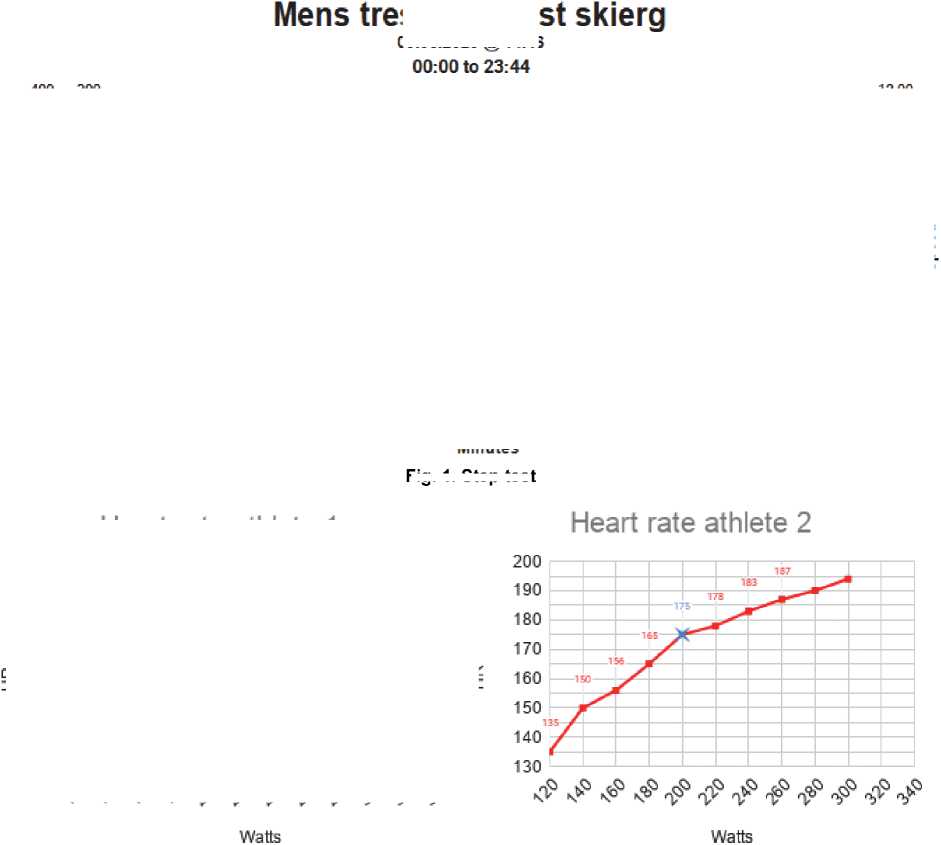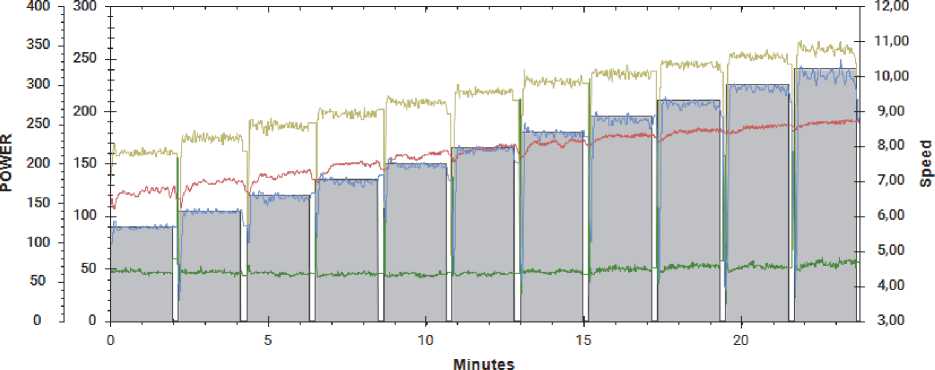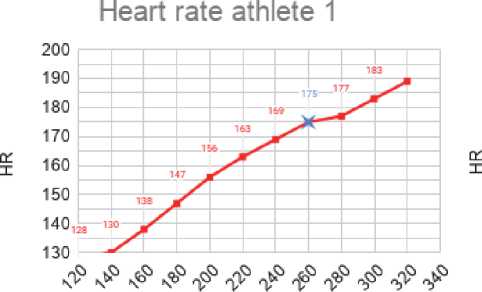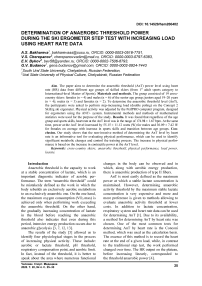Determination of anaerobic threshold powerduring the ski ergometer step test with increasing load using heart rate data
Автор: Bakhareva A.S., Cherepanov V.S., Bykov E.V., Budanov G.V.
Журнал: Человек. Спорт. Медицина @hsm-susu
Рубрика: Физиология
Статья в выпуске: 4 т.20, 2020 года.
Бесплатный доступ
Aim. The paper aims to determine the anaerobic threshold (AnT) power level using heart rate (HR) data from different age groups of skilled skiers (from 1st adult sports category to International-level Master of Sports). Materials and methods. The group consisted of 19 cross-country skiers: females (n = 4) and males (n = 6) of the senior age group; juniors aged 19-20 years (n = 4); males (n = 3) and females (n = 2). To determine the anaerobic threshold level (AnT), the participants were asked to perform step-increasing load (double poling) on the Concept 2 SkiErg ski ergometer. Physical activity was adjusted by the PerfPRO computer program, designed for ergometers using the ANT+ system. Instrumental methods and methods of mathematical statistics were used for the purpose of the study. Results. It was found that regardless of the age group and sports skills, heart rate at the AnT level was in the range of 174.98 ± 1.67 bpm. At the same time, power at the AnT level increased by 55.15 ± 11.12 watts (W) for males and 30.09 ± 7.42 W for females on average with increase in sports skills and transition between age groups. Con-clusion. Our study shows that the non-invasive method of determining the AnT level by heart rate is an informative tool for evaluating physical performance, which can be used to identify significant metabolic changes and control the training process. The increase in physical performance is based on the increase in contractile power at the AnT level.
Cross-country skiers, anaerobic threshold, physical performance, load power, lactate
Короткий адрес: https://sciup.org/147233624
IDR: 147233624 | УДК: 796.922 | DOI: 10.14529/hsm200402
Текст научной статьи Determination of anaerobic threshold powerduring the ski ergometer step test with increasing load using heart rate data
Anaerobic threshold is the capacity to work at a stable concentration of lactate, which is an important diagnostic indicator of aerobic performance. The term “anaerobic threshold” could be mistakenly defined as the work in which the body rebuilds an exclusively aerobic metabolism to an exclusively anaerobic one. On the one hand, the maximum oxygen consumption (VO 2 max) is achieved only when performing work exceeding the anaerobic threshold. On the other hand, the gradually increasing concentration of lactate in the blood before reaching the anaerobic threshold also indicates that even during this period, intensive energy production occurs due to anaerobic glycolysis [3, 7, 12, 13].
The results of the study [5] allowed us to identify four physiological stages in the process of increasing physical activity. These include: aerobic or lactate threshold, pH threshold, respiratory compensation point, and aerobic limit. In fact, instead of the threshold, it is better to speak about the area where numerous functional Человек. Спорт. Медицина 2020. Т. 20, № 4. С. 25–30
changes in the body can be observed and in which, along with aerobic energy production, there is anaerobic production of type II fibers.
AnT is most easily defined as the maximum power at which a stable lactate concentration is maintained. However, determining anaerobic activity threshold by the maximum stable lactate concentration is very expensive and more and more preference is given to methods allowing to evaluate anaerobic activity threshold at lower costs. In addition to lactate concentration, respiratory system and heart rate data can be used for determining AnT [1]. Due to its availability, a method for determining AnT by heart rate was chosen. One of the most common tests for determining AnT by heart rate is the Conconi method, which was used as the calculation basis. The essence of this method is to record the heart rate at the end of a given load, while, in contrast to the traditional step test, the work performed changed over time. The HR output on the plateau, before increasing linearly, corresponded to the threshold anaerobic power [4].
Materials and methods. The study was conducted on the premises of the Institute of Sport, Tourism and Service (South Ural State University, Chelyabinsk). The study group consisted of 19 cross-country skiers: females (n = 4) and males of the senior (n = 6) age group; juniors (n = 4); males (n = 3) and females (n = 2). To determine the AnT level, athletes were asked to perform a 2-minute increasing load (double poling) with a step of 20 watts (for males) and 10 watts (for females and juniors) on a ski ergometer (Fig. 1).
heart rate at 1 minute of rest; absolute maximum aerobic power (MAeP, W) and relative maximum aerobic power (RMAP (W/kg); heart rate at the anaerobic threshold level (AnT, HR); power at the anaerobic threshold level (Power at MAeP, W); concentration of peak lactate (mmol/l) in general blood flow at 3–4 minutes of recovery. The lactate level was assessed by taking capillary blood from finger1, using a portable Lactate Plus analyzer.
The calculation unit for determining AnT in our method was the average heart rate record
09.06.2020 @14:46


Fig. 1. Step test

Fig. 2. Graph for determining AnT based on heart rate (BPM) dependence on power (W)
The transition between stages consisted in stopping for 10 seconds to determine estimates of the load perception intensity. Testing was conducted before the subjective rejection. During physical work, the ergometer recorded the following data: total work time (min); heart rate (HR) at rest, maximum heart rate (HRmax) and at the last 30 seconds of the stage. After the data were obtained, a graph of the heart rate dependence (BPM) from power (W) (Fig. 2) was built (X axis – power, Y axis – heart rate). The inf- lection point on the graph was an anaerobic threshold.
The research procedure was carried out in the following order: 1) taking lactate samples at rest; 2) setting up heart-rate monitor; 3) selecting individually flywheel resistance by the built-in / auto program on the simulator; 4) setting standard load on the ergometer (5 minutes, 100 watt for males, 50 watt for females, double poling); 5) 2–3 minute rest; 6) test with increasing load (120 watt with a step of 20 watt for skilled males such as Candidates Masters of Sport and above this degree, 60 watts with a step of 10 watts for females); 7) measuring pulse at 1 minute of recovery and taking lactate 3–4 minutes after subjective failure. Statistical data processing was performed using the Statistica V.10.0 software.
Results and discussion. The analysis of data in Table 1 allows us to state that the crosscountry skiers' physical performance level increases with the transition from the junior to the senior age group and the increase in sports skills.
Regardless of the age group and sports skills, the heart rate at the AnT level was in the range of 174.98 ± 1.67 BPM. At the same time, the power at the AnT level increased by an average of 55.15 ± 11.12 W for males and 30.09 ± 7.42 W for females with the increase in sports skills and age group (Table 1).
Research results of a number of authors indicate that the increase in physical performance is based on a proportional increase in contractile power, blood supply speed and oxygen consumption. An equal increase in heart rate at different power indicates a greater increase in shock volume and a higher arteriovenous difference in oxygen in athletes with higher skills.
It is considered that the most informative method is AnT determination by a fixed lactate content in blood, equal to 4 mmol/l [9]. Therefore, for the reliability of the test for determining AnT by heart rate, we used a training protocol with an interval orientation, when power was detected at the point where the straight line of the graph reflecting the relationship between heart rate and power deviates to the side. The interval training protocol consisted of 4 intervals of 4 minutes with a 4-minute rest between intervals. After each interval, lactate was collected for 2–3 minutes of rest (Table 2).
In practice, when evaluating the anaerobic threshold, the maximum power developed by the muscles is determined, at which the lactate concentration in blood during the test fluctuates by no more than 1 mmol/l. Therefore, the AnT, identified according to the graph of the heart rate dependence on power, at the inflection point, is a valid indicator.
Conclusion
Load tests are used to determine only a specific physical task performance. Therefore, “general endurance” tests do not provide visual information about all the results for endurance. Due to the specifics of performed movements sequence, the test result on the bicycle ergometer only indicates the performance of cycling, which differs between lying and sitting positions. If making a conclusion about endurance based on other tests, it will be associated with greater or lesser errors. One of the criteria suitable for cross-country skiers to assess their physical per-
Table 1
Cross-country skiers' test with a step-up load to failure (M ± m)
|
Index |
Males, senior age n = 6 1st category |
Juniors n = 4 Candidate Masters of Sport |
Males n = 3 Masters of Sport, Masters of Sport of International level |
Females, senior age n = 4 1st category |
Females n = 2 Masters of Sport |
|
MAeP |
170,00 ± 10,95 |
245,00 ± 37,86 |
300,00 ± 20,00 |
127,50 ± 12,58 |
160,00 ± 28,28 |
|
RMAP (W/kg) |
2,68 ± 0,29 |
3,33 ± 0,28 |
3,83 ± 0,28 |
2,19 ± 0,06 |
2,53 ± 0,38 |
|
Power at MAP |
116,67 ± 16,33 |
192,00 ± 34,16 |
220,00 ± 34,64 |
82,50 ± 15,00 |
130,00 ± 28,28 |
|
HR AnT (BPM) |
176,17 ± 5,46 |
172,25 ± 9,57 |
175,00 ± 0,01 |
175,00 ± 1,83 |
176,50 ± 4,95 |
Table 2
Interval training protocol for cross-country skiers (M ± m)
Physical performance is an integral indicator characterizing the final result of morpho-functional adaptive changes in athlete's body. The physiological basis for the physical performance of a cross-country skier is aerobic energy supply mechanisms, as evidenced by the high VO 2 max values of world-class skiers (> 80 and ~ 70 ml · kg–1 · min–1 for men and women, respectively) [11]. One of the most informative indicators, characterizing an athlete's aerobic performance is the power developed at the level of AnT [6]. With a maximum work duration of more than 3–4 minutes, the power developed by the muscle will be proportional to the speed of its oxygen consumption. The higher the power, the higher the blood supply is. Therefore, an operational and less complex determination of AnT level, in this case by heart rate, will allow timely and rational decision-making in the training process management [10].
Список литературы Determination of anaerobic threshold powerduring the ski ergometer step test with increasing load using heart rate data
- Beneke R., Leithäuser R.M., Ochentel O. Blood Lactate Diagnostics in Exercise Testing and Training. Int J Sports Physiol Perform, 2011, no. 6 (1), pp. 8-24. DOI: 10.1123/ijspp.6.1.8
- Carlsson M., Carlsson T., Hammar-ström D. et al. Validation of Physiological Tests in Relation to Competitive Performances in Elite Male Distance Cross-Country Skiing. J Strength Cond Res., 2012, no. 26 (6), pp. 1496-1504. DOI: 10.1519/JSC.0b013e318231a799
- Danielsen J., Sandbakk 0., Holmberg H.-C., Ettema G. Mechanical Energy and Propulsion in Ergometr Double Poling by CrossCountry Skiers. Med Sci Sports Exerc., 2015, no. 47 (12), pp. 2586-2594. DOI: 10.1123/ijspp. 2016-0749
- Faude O., Kindermann W., Meyer T. Lactate Threshold Concepts: how Valid are they? Sports Med, 2009, no. 39 (6), pp. 469-490. DOI: 10.2165/00007256-200939060-00003
- Lelyavina T.A., Sitnikova M.Yu., Berezina A.V., Shlyakhto E.V. [Meaning and Correctness of the Term Anaerobic Threshold. Threshold Changes in Compensatory-Adaptive Reactions with Increasing Physical Activity]. Rossiyskiy kardiologicheskiy zhurnal [Russian Journal of Cardiology], 2014, vol. 11 (115), pp. 19-24. (in Russ.) DOI: 10.15829/1560-40712014-11-19-24
- Losnegard T. Energy System Contribution During Competitive Cross-Country Skiing. Eur J Appl Physiol., 2019, no. 119 (8), pp. 1675-1690. DOI: 10.1007/s00421-019-04158-x
- Lyudinina A.Yu., Garnov I.O., Bush-manova E.A. et al. Evaluation of the Relationship Between the Rate of Fat Oxidation and the Indices of Aerobic Performance in Race-Skiers. Human. Sport. Medicine, 2020, vol. 20, no. 1, pp. 5-12. (in Russ.)
- 0steras S., Welde B., Danielsen J. et al. Contribution of Upper-Body Strength, Body Composition, and Maximal Oxygen Uptake to Predict Double Poling Power and Overall Performance in Female Cross-Country Skiers. J Strength Cond Res., 2016, no. 30 (9), pp. 2557-2564. DOI: 10.1519/JSC.0000000000001345
- Popov D.V., Grushin A.A., Vinogrado-va O.L. Fiziologicheskiye osnovy otsenki aerob-nykh vozmozhnostey i podbora trenirovochnykh nagruzok v lyzhnom sporte i biatlone [Physiological Bases for Assessing Aerobic Capabilities and Selection of Training Loads in Skiing and Biathlon]. Moscow, Soviet Sport Publ., 2014. 78 p.
- Sandbakk 0. The Evolution of Champion Cross-Country-Skier Training: from Lumberjacks to Professional Athletes. Int J Sports Physiol Perform, 2017, vol. 12, no. 4, pp. 254-259. DOI: 10.1123/ ijspp.2016-0816
- Sandbakk 0., Holmberg H-C. Physiological Capacity and Training Routines of Elite Cross-Country Skiers: Approaching the Upper Limits of Human Endurance. Int J Sports Physiol Perform., 2017, no. 12 (8), pp. 1003-1011. DOI: 10.1123/ijspp.2016-0749
- Shmidt R.F., Lang F., Khekmann M. Fiziologiya cheloveka s osnovami patofiziologii [Human Physiology with the Basics of Pathophysiology], russian translation: M.A. Kamen-skaya. Moscow, Laboratory of Knowledge Publ., 2019.pp.429-445.
- Skattebo 0., Hallen J., Ronnestad B.R., Losnegard T. Upper Body Heavy Strength Training Does Not Affect Performance in Junior Female Cross-Country Skiers. Scand J Med Sci Sports, 2015, no. 29, pp. 1007-1016. DOI: 10.1111/sms.12517
- Tonnessen E., Haugen T.A., Hem E. et al. Maximal Aerobic Capacity in the Winter-Olympics Endurance Disciplines: Olympic-Medal Benchmarks for the Time Period 1990-2013. Int J Sports Physiol Perform., 2015, no. 10 (7), pp. 835-839. DOI: 10.1123/ijspp.2014-0431
- Undebakke V., Berg J., Tjonna A.E., Sandbakk O. Comparison of Physiological and Perceptual Responses to Upper-, Lower-, and Whole-Body Exercise in Elite Cross-Country Skiers. J Strength Cond Res, 2019, no. 33 (4), pp. 1086-1094. DOI: 10.1519/JSC. 0000000000003078


